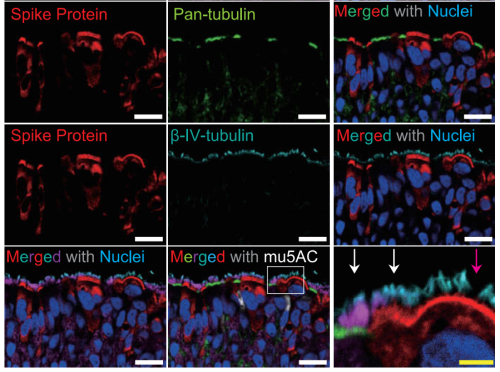Researcher Develop Ex Vivo Reconstructed Multi-sectional Respiratory Organoid in Responds to COVID-19
Date:25-02-2021 | 【Print】 【close】
Ever since the beginning of the COVID-19 pandemic, Prof. LI Liang and his team from the Institute of Biomedicine and Biotechnology, the Third People’s Hospital of Shenzhen, and Shenzhen Center for Disease Control and Prevention, have been studying the mechanism of SARS-CoV-2 infection and transmission, as well as developing the public health strategies to reduce the spread of COVID-19. After a year-long effort, new discoveries and observations on COVID-19 have been made.
Prof. Li’s team developed ex vivo reconstructed multi-sectional respiratory organoids. Together with their collaborators, SARS-CoV-2 infection was successfully conducted in these respiratory organoids and studied for its infection and host response mechanisms. The respiratory organoids also served as a drug-screening platform for the development of potential treatment options. Collaborating with the Third People’s Hospital of Shenzhen, the team has also profiled the viral shedding routine and duration for SARS-CoV-2 to provide necessary information to reduce the spread of COVID-19, with a special emphasis on the environmental fomites around asymptomatic patients. They discovered that SARS-CoV-2 could spread through the respiratory tract as well as the digestive tract, and the virus shedding lasts much longer than the symptoms. Even for asymptomatic patients, virus contamination can be found in the close contact environment. Patients with higher virus load in the nasal and throat area are easier to contaminate the environment through virus shedding. Door knobs and toilets have been shown to have high virus load on the surfaces. As a result, disinfecting an asymptomatic carrier’s close environment should be a major measure in the control and prevention of COVID-19. It’s also important to stay vigilant even when the patient shows no symptoms. The latest research results have provided significant insights on COVID-19 and have been published in Gastroenterology and the American Journal of Respiratory and Critical Care Medicine. The research outcomes from Li’s team has attracted both local and overseas companies for industrial applications, with an announced collaboration with Lipigon Pharmaceuticals to develop novel treatments for COVID-19.

Media Contact:
LONG Yueyue
Email: yy.long@siat.ac.cn